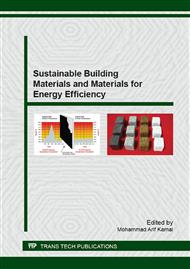p.1
p.13
p.21
p.29
p.38
p.51
p.71
p.82
Alternative Building Material Using Industrial and Agricultural Wastes
Abstract:
The conventional building material used in the construction industry in India is the burnt clay brick which has high embodied energy (1.4W/m K). It causes significant environmental hazards as it consumes considerable amount of top soil. Hence there is a need to produce environmentally responsive building materials for the construction of new buildings in order to meet the rapid urban growth. As an alternative, natural resources used in conventional building material can be replaced by industrial and agricultural wastes like fly ash, copper slag and phosphogypsum, slag to address and solve socio-economic problems such as employment, shortage of residential spaces while ensuring the economic feasibility. This paper thus attempts to identify an eco-friendly alternative building material by utilizing wastes from industrial & agricultural sites as partial substitutes of sand, cement or aggregates, thereby reducing continuous exploitation of these natural resources. . The properties of the alternative building wall materials are identified and compared with that of conventional bricks. Additionally the thermal conductivity of the proposed block is determined and compared with that of brick to provide a comfortable building environment for the end user.
Info:
Periodical:
Pages:
1-12
Citation:
Online since:
July 2015
Authors:
Price:
Сopyright:
© 2015 Trans Tech Publications Ltd. All Rights Reserved
Share:
Citation:


